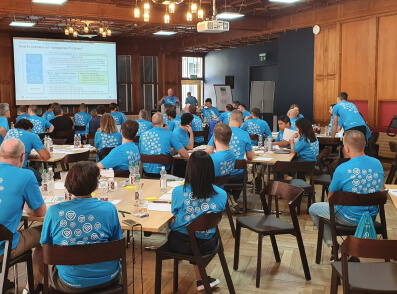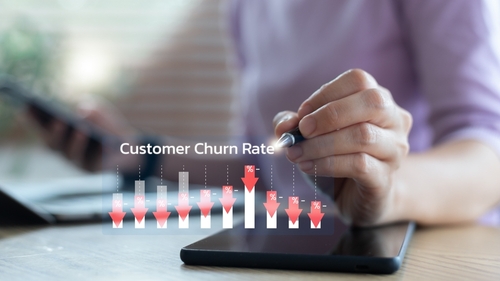Key Takeaways
- Today’s insurance companies use data to shift from reactive to proactive models, improving risk assessment precision and enabling preventative interventions.
- Data-driven digital health engagement platforms demonstrably reduce healthcare costs—by 4.9% in year one and 5.3% in year two—while strengthening customer relationships.
- Leading insurers are also leveraging AI and real-time data to transform operations, with proven results like faster claims processing.
Data-Driven Insurance: Strategies and Case Studies
Insurance has always been a data-intensive industry. From actuarial tables to claims histories, data is the foundation upon which insurance products are built and priced. Today, however, the sheer volume and variety of available data and data tools has transformed what’s possible in insurance. Insurers are discovering powerful ways to harness data that improves how they assess risk, engage customers, and deliver services. They’re creating more personalized experiences, streamlining operations, and developing entirely new business models built on data-driven insights.
This article reveals five data strategies that are working for today’s insurers, backed by real-world success stories.
Why Data-Driven Customer Insights Matter in Insurance
Modern insurers monetize data to create new revenue streams while personalizing products based on individual behaviors rather than broad demographics. They process claims in seconds rather than days or weeks. They identify risk with greater precision than ever before. And they build deeper customer relationships through continuous engagement rather than annual renewals.
The most powerful shift is from reactive to proactive insurance models. Instead of simply paying claims after events occur, forward-thinking insurers now use data in two transformative ways: to better understand and price risks with greater precision, and to work with customers to prevent losses before they happen. This fundamental change expands the insurer’s role from financial protection provider to both risk assessment expert and prevention partner.
So, how exactly do insurers use data to achieve these results?
5 Data-Driven Strategies Transforming Insurance
1. Digital Health Engagement Platforms
Health and life insurers increasingly implement digital platforms that encourage ongoing engagement with wellness activities. These platforms combine health tracking, personalized guidance, social engagement, and incentives to drive positive behavior change that benefits both customers and insurers.
dacadoo offers two complementary tools that exemplify this approach. Our data-driven Digital Health Engagement Platform (DHEP) enables users to track physical activities, set personal health goals, participate in challenges, and receive personalized coaching.
For risk assessment, our Risk Engine transforms limited self-reported health and lifestyle data into continuous risk insights. The engine calculates mortality and morbidity probabilities using as few as four data points (age, sex, weight, height) but can incorporate up to 100 different metrics. This scientific approach achieves 91.6% accuracy in estimating relative mortality probabilities.
The business value comes from both improved risk assessment and stronger customer retention, as policyholders receive tangible benefits from sharing their health data.
Use Cases
- Health Insurance: Wellness platforms gamify activities and preventive care, turning abstract health goals into concrete, achievable actions. These platforms typically include challenges, rewards, and social components that make healthy behaviors more engaging.
- Life Insurance: Apps integrated with wearables reward healthy behaviors with premium discounts or other incentives. By encouraging regular physical activity, proper sleep, and other health-promoting behaviors, these programs benefit both the insurer and the insured.
2. Real-Time Data Collection and Analysis
Real-time data collection transforms how insurers understand and manage risk. Unlike traditional models that rely on periodic data gathering, real-time data collection provides immediate insights into changing risk conditions.
This strategy enables insurers to dynamically adjust premiums based on actual behaviors rather than demographic assumptions. An International Journal of Future Mathematics and Research study reported a 31.8% increase in risk assessment accuracy and a 67.5% decrease in underwriting processing time after implementing real-time data analytics.
Use Cases
- Auto Insurance: Telematics devices and smartphone apps continuously monitor driving behavior, enabling usage-based insurance models where premiums adjust based on actual driving patterns.
- Property Insurance: IoT sensors in homes and commercial buildings detect conditions that precede damage claims.
- Health Insurance: Tools like dacadoo enable continuous health monitoring, allowing insurers to identify concerning trends early and encourage preventive interventions that reduce healthcare costs.
3. Predictive Analytics for Claims Processing
Predictive analytics transforms claims handling from a reactive, manual process into a proactive, data-driven operation. These technologies analyze vast amounts of historical and real-time data to improve efficiency, accuracy, and customer experience throughout the claims journey.
Machine learning algorithms can predict claim severity, identify fraud indicators, and optimize resource allocation—all while processing claims faster and more consistently than traditional methods.
Use Cases
- Auto Insurance: AI models analyze accident photos, vehicle data, and claim details to estimate repair costs and route claims appropriately. This speeds up resolution for legitimate claims while flagging potential fraud for investigation.
- Health Insurance: Health engagement apps like dacadoo recognize patterns that lead to complications or readmissions, allowing insurers to work with providers on preventive interventions.
4. AI and Natural Language Processing Applications
Artificial intelligence, particularly natural language processing (NLP), handles complex information processing tasks across insurance types. These technologies automate document analysis, customer interactions, and decision-making processes that previously required extensive human effort.
According to Accenture research, less than half of claims executives say their organizations are advanced in use of AI and machine learning-based data analytics, 80% say these technologies can bring more value, and 65% say they plan to invest more than $10 million into AI in the next three years.
Use Cases
- Commercial Insurance: NLP systems extract key information from lengthy policy documents and business submissions. This technology reads and interprets complex contracts, industry-specific terminology, and regulatory requirements at speeds impossible for human underwriters.
- Health Insurance: AI analyzes medical records to identify inconsistencies and optimize coverage decisions. These systems can review thousands of pages of medical history to flag potential issues or coverage gaps in moments rather than days.
5. Personalized Customer Journeys Through Data
Data-driven personalization creates insurance experiences tailored to individual needs, preferences, and risk profiles. By analyzing customer data across touchpoints, insurers can deliver relevant communications, recommend appropriate coverage, and provide personalized service at every interaction.
This strategy transforms the traditional one-size-fits-all insurance approach into a highly customized relationship that increases engagement, satisfaction, and loyalty.
Use Cases
- Life Insurance: Systems recognize significant life events (marriage, children, home purchase) to trigger relevant coverage recommendations. By monitoring customer data with permission, insurers can reach out at moments when protection needs to change.
- Auto Insurance: Driver feedback apps provide personalized tips based on actual driving patterns. These applications identify specific behaviors like harsh braking or rapid acceleration and offer targeted coaching to improve safety.
- Health Insurance: Communications adapt to individual health literacy levels and preferred channels. Instead of generic health information, customers receive personalized content relevant to their specific conditions and previous interactions.
Data-Driven Insurance Case Studies
Cutting Healthcare Costs with a Digital Health App
A Dutch Health Insurer launched a wellness app designed to help users track and improve their health. A study into its effectiveness demonstrated the significant impact of digital health engagement platforms on healthcare costs and utilization. The research analyzed data from 15,506 participants and found that implementing a digital health platform reduced healthcare costs by 4.9% in the first year, increasing to 5.3% in the second year. This translated to approximately $133 per person in the first year and $152 per person in the second year of savings.
Frequency of platform use proved more important than intensity—regular, sustained engagement delivered greater cost reduction than occasional intensive use. This demonstrates that digital health platforms create measurable benefits while improving health outcomes. For insurers, the dual benefit of cost reduction and customer engagement makes these platforms particularly valuable data innovations.
Progressive: Improving Risk Assessment and Lowering Insurance Costs with Telematics Data
Progressive’s Snapshot program is one of the industry’s most successful implementations of usage-based insurance powered by telematics data. Progressive personalizes car insurance rates based on actual driving behavior rather than traditional rating factors alone. It gathers this data through either a mobile app or plug-in device that picks up on hard brakes, fast accelerations, time of day, phone usage while driving, and overall mileage.
According to Progressive, the company has handed out over $1.2 billion in discounts through the Snapshot program. Drivers who save with Snapshot save an average of $231 per year after program completion.
Progressive’s data-driven approach delivers multiple business benefits: more accurate risk assessment, improved customer engagement through regular app interactions, and the ability to influence driving behavior toward safer practices that ultimately reduce claims.
Lemonade: Lowering Claims Processing Costs with AI
Lemonade has revolutionized claims processing by implementing AI Jim, a claims bot that handles approximately one-third of their claims without human intervention.
According to Lemonade’s reports, AI Jim processed over 30% of claims autonomously in 2021, with an average claims settlement time of just 3 seconds. This is achieved through AI Jim’s sophisticated ability to analyze claims data, assess policy coverage, and make accurate payout decisions using natural language processing and machine learning algorithms.
The company’s ability to deliver instant claim payments creates a powerful differentiator in an industry traditionally known for lengthy settlement processes.
Transform Your Insurance Operations with Data Innovation
Data-driven innovation transforms insurance operations through measurable improvements in risk assessment, claims processing, and customer engagement. Organizations achieve significant operational improvements through strategic data utilization while enhancing customer experiences.
For insurers seeking to transform their operations through data innovation, dacadoo offers comprehensive solutions for enhancing efficiency and improving policyholder outcomes. Book a demo today to see how you can leverage data-driven innovations to create a competitive advantage in the evolving insurance landscape.




















